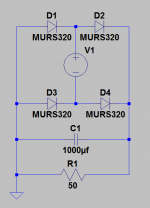It has a ceramic bypass as well.
Bypassing with a small cap is standard practice in locations like this.
The small cap takes over at high frequency where the self inductance of a large electrolytic starts to limit its performance.
So really only C803/C804 are filtering.
I meant that they are the ones I'm interested in. C805 is filtering as well but I'm not interested in that rail.
Ok, interesting. I will try and understand the topology of this supply.The small cap takes over at high frequency where the self inductance of a large electrolytic starts to limit its performance.
Are there any considerations when choosing the specs for C802? I put a Panasonic FR in that spot, low ESR type. I only know that I usually don't install low ESR caps after regulators.
Sorry for being off-topic but can you please explain that....Increasing the value means the rectifiers conduct for a shorter time (because the cap holds more energy as it discharges between cycles), however they conduct 'harder' drawing more current over that shorter time. That can in extreme cases cause transformer saturation ....
Last edited:
Sorry for being off-topic but can you please explain that.
No problem 🙂
The transformer and rectifiers actually only conduct very briefly to 'top off' the charge on the reservoir caps. Remember that the transformer voltage is a sine wave... and that the rectifier charges the caps to the peak value of that sine.
The voltage from the tranny soon falls away each cycle leaving the cap to supply the energy to the circuit. A small cap means the voltage collapses on the cap more quickly (a high ripple) but also means the rectifier has chance to conduct for longer as the next cycle starts climbing up towards its peak. The big cap develops smaller ripple but the same amount of energy that the circuit uses has to be put back. The big caps voltage has fallen less (lower ripple) and so the incoming AC has to reach nearer to its peak before the diode rectifier can begin to conduct.
The same energy has to be replaced whether big or small cap, so for the big cap it draws lots of current for less time. That causes its charge current to be very spiky and high amplitude.
Here is a 50 volt DC supply feeding a 50 ohm resistor. So 1 amp is drawn.
The waveforms show the result of changing the cap from a 1000 to 10,000uf. Look at the scale at the left and also the shape of the current. These are for two of the four diodes in the bridge.
Attachments
Are there any considerations when choosing the specs for C802? I put a Panasonic FR in that spot, low ESR type.
I would always go for good commercial quality caps of 105C rating from a recognised brand leader such as Rubycon, Vishay, Panasonic etc.
The small cap takes over at high frequency where the self inductance of a large electrolytic starts to limit its performance.
Is there a more preferred type of cap for this job? Like ceramic over film? The ratio seems like 1/10.000 for capacitance.
Paralleled low esr caps give ringing problems.
Check some of EVA's posts. There are others, but I don't recall any names.
A high esr small capacitor at the load is usually OK.
Check some of EVA's posts. There are others, but I don't recall any names.
A high esr small capacitor at the load is usually OK.
Paralleled low esr caps give ringing problems.
Check some of EVA's posts. There are others, but I don't recall any names.
A high esr small capacitor at the load is usually OK.
low esr caps should NOT be paralleled.Should the large output caps (4700uF in my case) be bypassed? If so, 1-2uF Wima should work?
low esr caps should NOT be paralleled.
I'm using Panasonic TS-HA as output caps. Those, as far as I know, are not rated especially for low ESR.
I don't know the Panasonic esr, but it sounds like a "higher" quality cap and that often equates to lower esr.
The Wima is definitely lower esr.
Do not parallel them, i.e. never listen to a recommendation to bypass electrolytics with plastic film capacitor/s
The Wima is definitely lower esr.
Do not parallel them, i.e. never listen to a recommendation to bypass electrolytics with plastic film capacitor/s
elaboration.
Don't bypass an electrolytic with a capacitor.
Especially when one, or both, are low esr.
Don't bypass an electrolytic with a capacitor.
Especially when one, or both, are low esr.
Paralleled low esr caps give ringing problems.
Check some of EVA's posts. There are others, but I don't recall any names................
Especially when one, or both, are low esr.
That means that never ever it is a good practice to bypass capacitors with film ones (as all film are low esr by design).
It seemed to me that people often preferred to do this as an upgrade. You say that basically they should have problems with their setup? Or that only in some particular circumstances that are not so common, issues might appear?
- Status
- Not open for further replies.
- Home
- Amplifiers
- Solid State
- to92 transistor replacement


